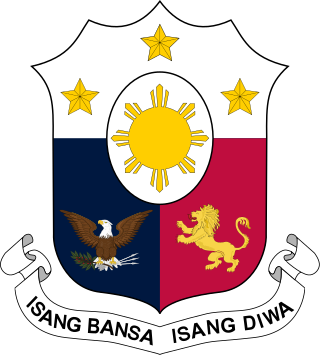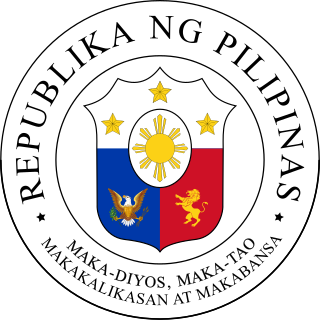
"Lupang Hinirang", originally titled in Spanish as "Marcha Nacional Filipina", and commonly and informally known by its incipit "Bayang Magiliw", is the national anthem of the Philippines. Its music was composed in 1898 by Julián Felipe, and the lyrics were adopted from the Spanish poem "Filipinas", written by José Palma in 1899.

The coat of arms of the Philippines features the eight-rayed sun of the Philippines with each ray representing the eight provinces which were placed under martial law by Governor-General Ramón Blanco Sr. during the Philippine Revolution, and the three five-pointed stars representing the three major island groups of Luzon, the Visayas, and Mindanao.

The national flag of the Philippines is a horizontal bicolor flag with equal bands of royal blue and crimson red, with a white, equilateral triangle at the hoist. In the center of the triangle is a golden-yellow sun with eight primary rays, to represent the original eight provinces that rebelled against the Spanish during the 1896 Philippine Revolution. At each vertex of the triangle is a five-pointed, golden-yellow star, each of which representing one of the country's three main island groups—Luzon, Visayas, and Mindanao. The white triangle at the hoist represents liberty, equality, and fraternity. A unique feature of this flag is its usage to indicate a state of war if it is displayed with the red side on top, which is effectively achieved by flipping the flag upside-down.

Maria Elisa Cristobal Anson-Rodrigo, better known as Boots Anson-Roa, is a Filipina actress, columnist, editor, and lecturer.
The Pledge of Allegiance to the Philippine Flag, or simply the Pledge to the Philippine Flag, is the pledge to the flag of the Philippines. It is one of two national pledges, the other being the Patriotic Oath, which is the Philippine national pledge.

Teresita Rigo Durango Magalona, known professionally as Tita Duran, was a Filipino film actress who began as a child actress. She was the first successful child star of Philippine cinema.

Christopher Strauss de León, also known as Boyet, is a Filipino actor, filmmaker and politician. Often referred to as the "King of Philippine Drama", he gained stardom for his leading man roles in numerous film and television productions including period, romantic drama and thriller. His work has received various accolades throughout his career spanning five decades, including eight FAMAS Awards, two Gawad Urian Awards, four Luna Awards, nine Star Awards, and eight Metro Manila Film Festival Awards.

The Philippine Star is an English-language newspaper in the Philippines and the flagship brand of the Philstar Media Group. First published on July 28, 1986, by veteran journalists Betty Go-Belmonte, Max Soliven and Art Borjal, it is one of several Philippine newspapers founded after the 1986 People Power Revolution.
The national symbols of the Philippines consist of symbols that represent Philippine traditions and ideals and convey the principles of sovereignty and national solidarity of the Filipino people. Some of these symbols namely the national flag, the Great Seal, the coat of arms and the national motto are stated in the Flag and Heraldic Code of the Philippines, which is also known as Republic Act 8491. In the Constitution of the Philippines, the Filipino language is stated as the national language of the Philippines. Aside from those stated symbols in the Constitution and in Republic Act 8491, there are only six official national symbols of the Philippines enacted through law, namely sampaguita as national flower, narra as national tree, the Philippine eagle as national bird, Philippine pearl as national gem, arnis as national martial art and sport and the Filipino Sign Language as the national sign language. Thus, there is a total of twelve official national symbols passed through Philippine laws.
Tessy Alfonso, better known by her stage name Sampaguita, is a Pinoy rock singer from the Philippines, active during the 1970s and 1980s. Sampaguita had released several albums and songs that went successful and are now considered classics. She is also dubbed as the "Queen of Filipino rock music."
Ernani Joson Cuenco was a Filipino composer, film scorer, musical director, music teacher and Philippine National Artist for Music. He wrote an outstanding and memorable body of works that resonate with the Filipino sense of musicality and which embody an ingenious voice that raises the aesthetic dimensions of contemporary Filipino music. Cuenco played with the Filipino Youth Symphony Orchestra and the Manila Symphony Orchestra from 1960 to 1968, and the Manila Chamber Soloists from 1966 to 1970. He completed a music degree in piano and cello from the University of Santo Tomas where he also taught for decades until his death in 1988.
Ramon Montaño was a Filipino politician and military officer.

Isang Bansa, Isang Diwa was the national motto of the Philippines from 1978 to 1986, during the presidency of President Ferdinand Marcos. It was adopted on June 9, 1978 by virtue of Presidential Decree No. 1413. The motto has been criticized and has been denounced as "the slogan of a fascist regime".

The Independence Flagpole or the Philippine National Flagpole is a 45.72 m (150.0 ft) flagpole located near the Rizal Monument in Rizal Park in Manila, Philippines. It is the highest flagpole in the country.

The Great Seal of the Philippines is used to authenticate official documents of the government of the Philippines.
The national motto of the Philippines may refer to:
Magkano ang Iyong Dangal? is a 1988 Filipino romantic drama film directed by Laurice Guillen and starring Christopher de Leon, Zsa Zsa Padilla, Joel Torre, Jestoni Alarcon, Princess Punzalan, and Michael Locsin. Adapted from the "komik" of the same name by Gilda Olvidado, the film is about the adulteries committed by married couple Paolo and Era, played by de Leon and Padilla respectively. It was released on December 25, 1988, as part of the 14th Metro Manila Film Festival (MMFF).

The 2022 presidential campaign of Isko Moreno began on September 22, 2021, when Isko Moreno announced his intention to run for the presidency in the 2022 Philippine presidential election. Isko Moreno has served as the mayor of Manila, the country's capital city, from June 30, 2019 to June 30, 2022.
Lorna Taaca Pantajo-Kapunan is a Filipino lawyer, radio host, and columnist.












